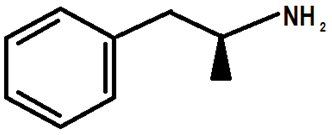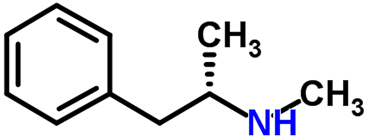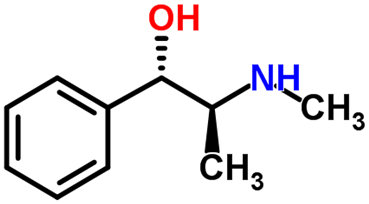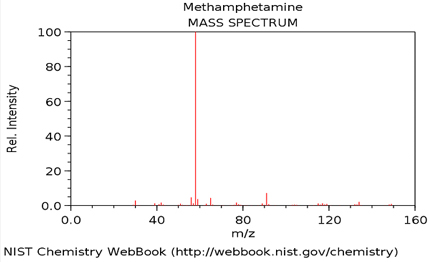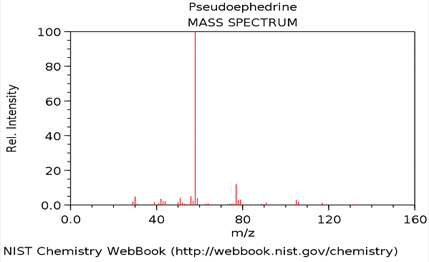
|
Introduction On December 22, 2015, a urine sample (UA) was collected from an ex-convict suspected of methamphetamine use. When the test came back positive, he was subsequently charged. With the prospect of a violation of his existing release looming, he reached out to a consulting chemist, Dr. David Manuta at Manuta Chemical Consulting, Inc., to review his case. He claimed to have not previously tested positive for any Drugs of Abuse since he was paroled. A hearing was held by The Colorado Department of Corrections (CDOC) on January 12, 2016. Background Information In the document faxed to Dr. Manuta by the Defendant, he described the medications that he was taking at the time, including prescriptions. The defendant also indicated that the test reading for methamphetamine was 377 ng/mL (nanograms per milliliter). A test reading for amphetamine was also reported as 275 ng/mL. The nanogram is a metric mass unit equal to one-billionth of one gram (10-9 g), the mass of a typical human cell [1]. The Defendant identified the testing laboratory as Redwood Toxicology Laboratory (RTL). RTL is located in Santa Rosa, CA. With the testing located in California, the urine samples must be collected and preserved in accord with accepted protocols and standards prior to being shipped to the facility. CDOC personnel need to properly package these urine samples, per the accepted methodologies, in order for the test results obtained to be considered meaningful. In a medical report dated December 14, 2015, it is noted that the Defendant’s physician prescribed FLONASE nasal spray, neo-synephrine nasal spray, and Adderall XR. Other medications noted by the Defendant’s physician include Albuterol, Advair, and Lisinopril. The Defendant also noted that he and some of his family members had recently taken Sudafed® for nasal and sinus illnesses. The active ingredient in Sudafed® is the chemical pseudoephedrine.
Discussion CDOC regulations approve the use of immunoassay (IA) methodologies and gas chromatography-mass spectrometry (GC-MS) for the identification of Drugs of Abuse in urine [2]. According to ImmunoChemistry Technologies, LLC [3], the immunoassay methodologies offer rapid identification of specific molecules. An advantage of ImmunoChemistry Technologies is that many samples can be analyzed in a day via these techniques. False-positive test results can be obtained via the rapid identification techniques such as IA. A check on a positive sample with GC-MS enables one to have greater confidence in the test result [4]. Redwood Toxicology Laboratory (RTL), the laboratory used for the urine testing, indicates that approximately 85,000 urinalyses are done each week for Drugs of Abuse. This throughput level suggests that immunoassay methods are used at RTL [5]. This huge throughput corresponds to 12,000 samples per day, 500 samples per hour, and more than 8 samples per minute. Less than 10 seconds per sample appears to be the usual analysis time. Review of the analytical results may not be done prior to sending them to CDOC. RTL has two methods for determining methamphetamine in urine. The first method has a cut-off limit of 500 ng/mL and the second method has a cut-off limit of 1000 ng/mL [6]. The detection limit for methamphetamine was reported at 250 ng/mL. A key issue is that the Defendant’s apparent level of methamphetamine in his urine was 377 ng/mL. This level is less than the cut-off level that the RTL methods noted in the previous paragraph can detect. There is uncertainty on what was actually measured in the positive test reported by CDOC personnel to the Defendant. In addition to Sudafed®, the Defendant was known also to be taking Adderall XR. One of the conditions where Adderall XR is prescribed is to control the symptoms of Attention Deficit Hyperactivity Disorder (ADHD) [7]. The Defendant had been previously diagnosed with ADHD. Per his doctor’s orders, the Defendant was on a once-a-day 20 mg capsule regimen. One of the ingredients in Adderall XR is dextroamphetamine (C9H13N) [Fig. 1] [8]. Methamphetamine (C10H15N) bears similarities to dextroamphetamine in its chemical structure [Fig. 2] [9], as does pseudoephedrine (C10H15NO) [Fig. 3] [10].
The similarities between these three chemical structures are striking. As a result, there is, to a reasonable degree of scientific certainty, some doubt cast regarding whether the immunoassay methodologies used by RTL personnel are sensitive enough to consistently and reliably distinguish between these very similar molecules. The National Institutes of Health provides data on the biological half-life of pseudoephedrine, an active ingredient in Sudafed®. The half-life of pseudoephedrine is about six (6) hours. Depending on the pH of the urine, it can take up to 16 hours for pseudoephedrine to be eliminated in adults [11]. This means that, to a reasonable degree of scientific certainty, there would be residual pseudoephedrine in the Defendant’s urine within the 6-hour biological half-life window. Given this information, it is certainly possible that had the Defendant been required to submit a urine sample at a time near to when he had last taken Sudafed®, residual pseudoephedrine could be detected. It is reasonable then to consider that residual pseudoephedrine from Sudafed® could have been found, rather than methamphetamine, in the recent positive sample. RTL’s comprehensive urine drug test for 22 Drugs of Abuse does not include the detection of pseudoephedrine [12]. Based on the chemical structure similarities between methamphetamine and pseudoephedrine, one would expect their respective mass spectra to look alike. The National Institute of Standards and Technology (NIST) reference mass spectra bear this out as can be seen in Figures 4 and 5 [13]. It would require an experienced chemist to distinguish between these molecules, based on a thorough review of immunoassay test data. Due to the high throughput at the CDOC’s contract laboratory, the subtle mass spectral differences between methamphetamine and pseudoephedrine were apparently not examined further. Concluding Thoughts CDOC works with RTL on rapid identification of the possibly illegal substances found in urine. The Defendant provided urine samples when requested. This was apparently the first time that one of the Defendant’s urine samples was determined to have contained a possibly illegal substance. Based on the 6-hour biological half-life of pseudoephedrine, it is possible that the Defendant had residual pseudoephedrine in his urine concurrent with producing this test sample. In this instance, the identification of methamphetamine when residual pseudoephedrine is present results in a false-positive. Likewise, the prescription medication Adderall XR has amphetamine in it. The mass spectrum of amphetamine should be obtained when this urine sample is analyzed. In this instance, the presence of amphetamine is not a true false-positive; rather, it is what one expects to observe from a medication where amphetamine is one of its ingredients. Given the similar chemical structures of dextroamphetamine (in Adderall XR), methamphetamine, and pseudoephedrine, the immunoassay technique presently in use may not be consistently and reliably sensitive enough to distinguish between the subtle differences in these molecules. As a result, a false-positive for methamphetamine is not an improbable outcome. With the advent of automated systems containing “the library” of mass spectra, modern instrumentation performs matches of the unknown or sample mass spectrum with a known or reference mass spectrum in “the library.” The match of the unknown or sample mass spectrum with a known or reference mass spectrum in “the library” often, but not always, works well. As the mass spectra of methamphetamine and pseudoephedrine are nearly indistinguishable, this would be an example where a false-positive could occur. RTL’s huge throughput has prospective consequences associated with incomplete purging of the system between runs/trials. This can result in cross-contamination based on a residual amount of methamphetamine still present in the system from a previous run/trial. Also, the standard adult dose for pseudoephedrine is 60 mg. There are six orders of magnitude between mg and ng. As a result, even after multiple biological half-lives, the concentration of pseudoephedrine, detected as methamphetamine, in the parolee’s urine would be in the microgram per milliliter (μg/mL) range. Such concentrations would have, to a reasonable degree of scientific certainty, saturated the sensitive detector. Moreover, had the parolee been a habitual user of methamphetamine, he would have, to a reasonable degree of scientific certainty, tested positive for methamphetamine more often than this one time. When all of the information presented here is read with understanding, it is clear that false-positive results were obtained for methamphetamine and amphetamine in the urine sample collected. The Defendant was found not guilty at his January 12, 2016 hearing. His curfew ended and his ankle monitoring device was removed at that time. The CDOC appealed the initial exoneration. The parolee was released from custody when the appeal was unsuccessful. References
|
